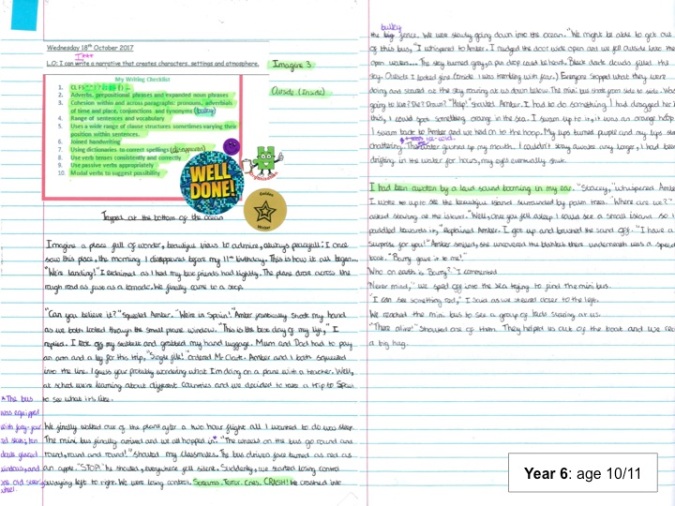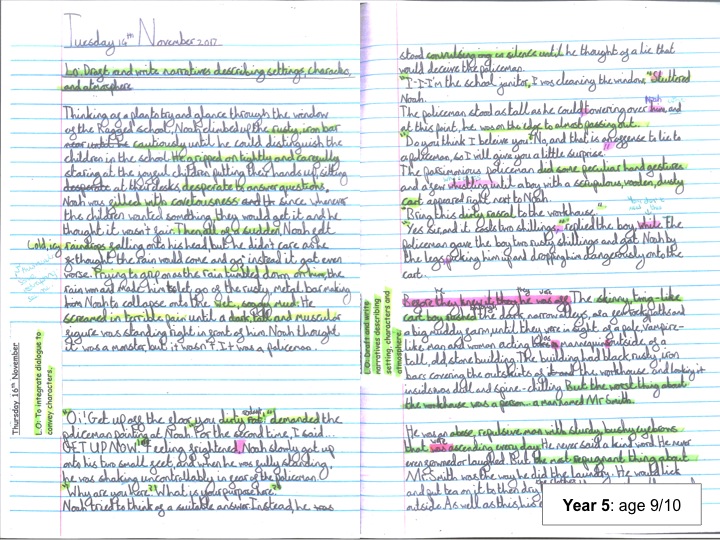I began my career as a primary school teacher in Year 6. This was all going swimmingly until I couldn’t face the pressure anymore of pretending I knew how to teach football skills to children who were already rooted in county teams; forced to demonstrate how to dribble a ball or shoot a basketball hoop. It was modeling the Haka in a pinafore dress* – somewhat incorrectly – that tipped me over the edge.
*Not recommended.

After moving to teach secondary for some years, I started a new full time role (last September) working for Greenshaw Learning Trust, and am loving the challenge. With a growing number of schools – half primary, half secondary – there’s immeasurable potential in the collaborative benefits of cross-school partnership. This might take the form of English HODs meeting together to share ideas and plans, discuss pedagogical approaches, moderate writing or share in CPD opportunities, or Primary Leads meeting to discuss frameworks for assessment in non-testing years, phonics or effective close reading strategies etc.
In recent months, I’ve noticed potential for enormous positive impact – and it’s a contentious area in the education-sphere which, honestly, baffles me.
Ten years into teaching and I still can’t quite comprehend why we, as dedicated and knowledgeable educators, don’t invest more in the academic transition between KS2 and KS3. Truthfully, the last few years have seen a real rise in pastoral improvements of this vulnerable period of change (which is fab) but, from a teaching and learning viewpoint, we appear to have seen no real gains – and this surprises me.

Over those ten years I’ve engaged in projects that have led me to visit countless schools across the country (not talking my own Trust here – though none of us would claim to be perfect yet either!) who’ve designed KS3 curriculum plans and SOWs that, while new and interesting, resemble little of the level of challenge that children are expected to achieve by the end of KS2.
aa
The familiar rhetoric I hear in conversations between the divorced worlds of Primary and Secondary tends to go like this:
aa
Primary:
KS3 teachers don’t even look at our assessments; they just roll out more baseline tests in Year 7 anyway. What’s the point of all our hard work?
Secondary:
KS2 teachers must be drilling children for Year 6 SATs. They come into my classroom and certainly don’t know much at all. KS2 tests must be flawed.
The truth is, both sides carry an element of truth but both are also riddled with errors.
aa
In my humble opinion, a more accurate picture looks like this:
Primary:
- a broad curriculum
- a cumulative approach to building knowledge
- a tough KS2 assessment – requires rehearsal (some say ‘drilling’)
- specialist teachers with a deep understanding of SPaG, the teaching of reading and writing, language acquisition, phonics etc.
- children benefit from teachers who know their class extremely well due to the primary classroom model – 5 days a week, same students all year, same environment, knows the 360o family context etc.
Secondary:
- end of KS2 assessments do not assess subject knowledge of foundation subjects; further assessments needed at KS3 point of entry
- more challenging knowledge content – reduced focus on basic skills, results in poorer appearance of basic literacy/numeracy abilities
- vulnerability in transition – big fish in a small ponds become small fish in an ocean
- pedagogical approaches / calculation strategies / terminology different between primary and secondary phases
- teachers possess a huge wealth of knowledge, though may be less specialist in how to articulate extended answers and write thorough responses, which incorporate this crucial subject knowledge
The cosmic chasm between these two realms makes them incomparable.
aa
One hurdle lies in the fact that primaries hold accountability for their students right until their departure at age 11 or 12, but nothing beyond. Results are entirely dependent on the level of progress they make in that school. Secondaries, however, are dependent on KS2 results to set the bar for expected progress at KS3 and 4.
aa
Without much awareness from secondary teachers as to what is required by the end of Key Stage 2, no matter how much energy we’ve given to writing that SOW for Year 7, we’re unintentionally doing a disservice to our students who arrive, keen, raring to learn and extremely capable.
aa

aa

In September 2015, Ofsted published a white paper, ‘Key Stage 3: the wasted years?’ which sought to highlight the depression in performance from KS2 to KS3.
Key findings from this report, among others, lists these three points:
- Key Stage 3 is not a high priority for many secondary school leaders in timetabling, assessment and monitoring of pupils’ progress. 85% of senior leaders interviewed said that they staff Key Stages 4 and 5 before Key Stage 3. Key Stage 3 is given lower priority, where classes are more often split between more than one teacher or where pupils are taught by non-specialists.
- Leaders prioritise the pastoral over the academic needs of pupils during transition from primary school. While this affects all pupils, it can have a particularly detrimental effect on the progress and engagement of the most able.
- Many secondary schools do not build sufficiently on pupils’ prior learning. Many of the senior leaders interviewed said that they do not do this well enough and accepted that some pupils would repeat some of what they had done in Key Stage 2. Pupil responses indicate that repeating work is more of an issue in mathematics and English than in the foundation subjects.
Questions to consider:
- Have you got a robust system in place that requires students to bring in samples of their best work on induction days – to record and share with teachers and tutors in advance of September?
- Are you aware of the expectations at KS2 in reading (pg6), writing (pg8), and SPaG?
- Have you spent time exploring the assessments students sit at the end of Year 6 in reading and SPaG?
- Are your expectations at KS3 offering natural progression of challenge from this point onwards, or are you inadvertently creating a culture that allows students to plateau through KS3?
- Do your Year 7 and 8 SOWs demonstrate high academic expectations, and does the teaching across your department reflect these?
- Have you visited a local primary school to see teaching and learning in action?
- Have you met KS2 Leads within your own academy trust/local area/feeder schools to hold professional conversations about what ‘challenge’ looks like in Year 6 and how you might be able to extend this the other side of the transition?

As I am moving into a senior leadership role with responsibility for KS3 progress and transition this has given me some thought provoking points to consider. I am particularly interested in developing my role to build these relationships with my feeder primaries to ensure a smoother transition and hopefully build that current invisible bridge to support transition within the curriculum. Any other hints or tips would be gratefully received. Thank you.
Great article, I think about this regularly and fear we are not doing enough! Lots to think about here. Thank you.